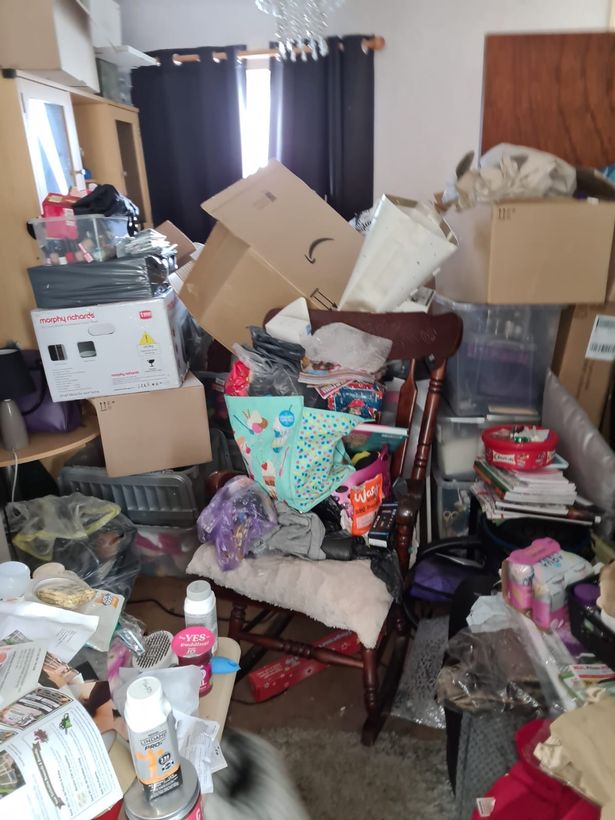'My 40-Year Struggle with Hoarding: Transforming My Home from Chaos to Calm' - OK! Magazine

Books and toys piled high, shopping still in grocery bags and brand new clothes collecting dust; a narrow pathway through each room and barely space to open a curtain – this was the home of a hoarder. Sue James, 57, from Birmingham, describes her house as 'what hell looked like' before she sought help but now after decades of accumulating 'stuff', the reformed hoarder opens up about living with the hidden mental health issue.
'I was a hoarder for nearly 40 years and I firmly believe it originated from my traumatic childhood. I had few toys of my own or real possessions to cherish and so when I finally left home at 18 I went shopping. I bought myself clothes and things for my house and from that day I said, 'Right, this is mine. I bought this for myself brand new. No one can make me share it or give it away.'
That's how my hoarding journey started – I'd had nothing that was purely mine before then and so I didn't want to let anything go. I was heavily pregnant when I split up with my first husband and my second husband had his own mental health struggles. I went on to be diagnosed with multiple sclerosis (MS) in my mid-twenties, which added to the stresses and strains of my life.
When my house was at its worst, it was filled to the brim with random things piled high, almost to the ceiling. I would buy shopping and didn't even take it out of the bags. There was nowhere to store anything in any cupboards so I would simply enter the house with my shopping and place the bag down. I'd just retrieve groceries from the bags when required.
There was probably a foot of space on either side of my bed, whilst on the settee in my sitting room I would have to keep shifting things about to sit down. There would be cascades of items every time I attempted to rest. I did have small pathways throughout the property so I could reach every room but I might not necessarily be able to get to the windows in these rooms to open them, or to draw the curtains. I had fire service safety inspections and they would tell me, 'Well, you can move around in the house but you know that there are safety risks. Things could fall on you or you could trip on things.'
I'd already spent my life tumbling over nothing – when I was diagnosed with MS my neurologist looked back over my medical history and realised my symptoms had begun when I was aged eight or nine. I've broken my left wrist 28 times and my right wrist twice, I've broken my ankle in five places and every finger and toe. So the condition of my home was even more perilous given my disability.
No one knew
Hygiene was never an issue when it comes to my hoarding, my bathroom and toilet were the only two rooms that weren't 'hoarded' and I was always clean and presentable when I left the house. I never struggled with disposing of rubbish or recycling properly – a crisp packet would invariably end up straight in the bin.
When it came to my hoarding, it centred around items that held genuine worth, whether financial or emotional. Books presented a massive challenge regarding my hoarding because their significance was instilled in me during childhood. The wisdom you can gain from books is precious, so I find it difficult to part with them.
Nobody was aware I was a hoarder – I wouldn't allow anyone into the house, guests were absolutely forbidden. Initially I felt content, surrounded by my gleaming new belongings that nobody could take from me. I relocated numerous times throughout the years and each time my home became slightly larger, providing me with additional space to store items.
However, I came to understand my children shouldn't have to endure that environment – it's hardly surprising my younger son is a minimalist now he's an adult and he's been incredibly supportive during my recovery. So approximately five years ago I decided to buckle down and confront my hoarding – I thought, 'I've got to do something about this.'
It was Christmas 2019 when I hit rock bottom. My electricity cut out and I went around the house attempting to reach the plug sockets to disconnect items, with enormous difficulty. I wanted to see if I could switch the circuit breaker on the fuse board to restore the power by doing this and I couldn't, so it was just my dog and I in the darkness for days. It was devastating. I was stumbling over items, injuring myself and I spent countless hours sitting in McDonald's drinking coffee and charging my phone.
I had no funds to get the electricity restored but eventually I shared my circumstances on a local community board and someone offered assistance without charging me a penny.
Reaching out for support
Taking the initial step is the most challenging, you have to allow people in – quite literally – and thankfully, everything is now falling into place and making sense for me. I spotted a woman advertising locally, she offered cleaning services and had several hours available each week. I was frightened to make contact, I explained I required physical assistance to organise my home, I attempted my best to describe what chaos looks like.
She arrived, and was met by mountains of boxes. I assumed she was going to withdraw. Rather, she said it was manageable – she collaborated with me four hours weekly and the progress has been enormous.
I wish to eliminate the shame surrounding hoarding, it is a concealed mental health condition that should be more openly discussed. Some individuals are too embarrassed to seek assistance, others don't know where to look. And it's about understanding how to help – you can't simply enter someone's house and declare, 'You've got too much stuff. You have to get rid of it. '
I'm now at the conclusion of my decluttering process – it's achievable to transform circumstances with the proper support, reports the Mirror.'
Visit www.cloudsend.org.uk for support and information about hoarding




